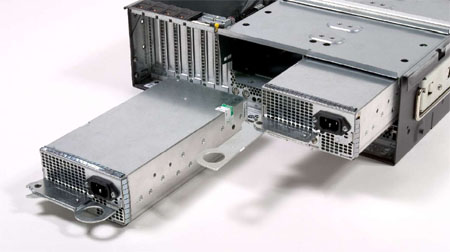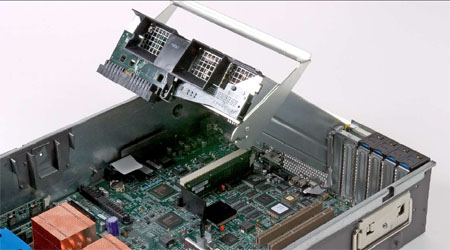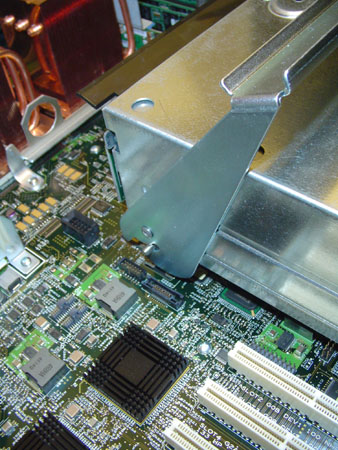Sun Fire V40z: Four Opterons in a 3U
by Kristopher Kubicki on February 22, 2005 12:05 AM EST- Posted in
- Systems
Storage and Power
Storage
As we mentioned earlier, the V40z’s six hot swappable Ultra320 storage bays utilize LSI’s 53C1020 SCSI controller to connect up to six LVD SCSI devices. The sixth expansion slot in the front of the server can be used for a floppy drive/DVD/CD drive combo, as illustrated in our configuration below.
Power
Power on our Sun V40z comes from two, redundant 760W power supplies – both hot swappable. A metal arm swings out from the back of each power supply, unlocking the unit for removal.The entire power supply housing comes apart from the main chassis of the case via a small locking device that connects the PSU bay to the hard drive. Another proprietary Sun interface carries power from the housing to the motherboard without any wires. With the enormous concerns for air flow inside the chassis, the removal of as much wiring as possible is an absolute must.
Under the power supply, we have room for a seventh horizontal 66MHz PCI expansion slot that connects via a vertical riser. Given the condition that we mentioned on the chipset page, this PCI slot should probably go unused.
As we also mentioned earlier, both of these power supplies are directly managed by the Service Processor. As a result, when plugging in the system, the Service Processor boots up automatically its own operating system to oversee the functionality of the rest of the computer. This intelligent design allows for us to view the exact details of power draw and operating temperature.













38 Comments
View All Comments
RadeonGuy - Tuesday, February 22, 2005 - link
I Wish I Had One*drool*
Ahkorishaan - Tuesday, February 22, 2005 - link
That thing is a monster! I can't even think of something to do with that much power... It would be wasted on anything I throw at it, that's for sure. Good thing I don't have 22,000 to throw away...Viditor - Tuesday, February 22, 2005 - link
Wow...what a machine! I'd read the pathscale record setting previously, but it looks like HP has a real headache here...(Dell isn't even in the game...)Doormat - Tuesday, February 22, 2005 - link
Yea the benchmarks are missing. I'd also like to see some reviews of "cheaper" (by an order of magnitude or so) 1U/2U 1/2-way systems. It'll be interesting to see what happens when dual core goes live later this year. I'd love to get some 1U 2-way servers and stick dual core chips in them. 4 procs in a 1U housing. Yeah. Baby.bersl2 - Tuesday, February 22, 2005 - link
#3: On the contrary. PPC runs embedded all the time.mickyb - Tuesday, February 22, 2005 - link
They don't work for me either. On another note, the PowerPC management board is interesting. I am familiar with the HP Integritry Management Board. I don't think it runs Linux. I wonder if AMD would be interested in making a management board based on the Geode processor. PowerPC seems a bit much.vaystrem - Tuesday, February 22, 2005 - link
Are the database benchmark images not working for anyone else?LeadFrog - Tuesday, February 22, 2005 - link
That is a beast.